Monday, December 7, 2009
A History
Prior to modern western history of South Africa we know of the kingdom of Manupungubwe (1075-1220). This state developed some of the land for use of agriculture to feed its increasing population. The kingdom of Manupungubwe derives it’s name from their capital city, the location of which is now one of South Africa’s National Parks. These people were initially drawn to this region due to the large population of elephants, more important than the elephants were their ivory tusks which were of significant value and retain a lot of their value even to this day. As this nation-state grew in size and power it moved northwards and became known as the Kingdom of Zimbabwe around the 13th century. Some of whose stone buildings are still around to this present day.
European’s involvement in the history of South Africa begins in 1503 when Antonio de Salanha landed at Table Bay which would later become known as Cape Good. 150 years later, the first Dutch settlers came to Cape Good and formed a port to replenish ships that were travelling from Asia to Europe. The Dutch East India Company governed Cape Good until 1795. Other European powers realized the significance of having control over Cape Good. 200 of the French Huguenots came to South Africa and settled the town of Fransch Hoek. In 1795 British soldiers seized Cape Good fearing a Rebellion incited by French inhabitants. While the control of the British Empire the war against the native Xhosa people was expanded, and more territory was claimed for the use of Great Britain. When England abolished slavery in it’s colonies in 1833, 12,000 of the native population (Boers) who had been previously held under British control left Cape Good and formed the Boer-Republic. Gold and Diamonds were found in 1867 which triggered even more Europeans to move into South Africa, and furthered the subjugation of native Africans . The first Boer War lasted from 1880-81 and was a victory for the Boer-Republic largely due to their guerilla-style warfare tactics. However in the Second Boer War (1899-1902), England returned with a stronger army and defeated the Boer Republic -- afterwards, creating the Union of South Africa as a dominion under British rule.
In 1948 the National Party was elected, this government distinguished races in their laws and granted privileges to the population based on their skin color. This system came to be known as apartheid. In recent years certain organizations have been trying to undo the disadvantages that the native population has been subjected to. However progress has been mitigated due to economic difficulties, as well as the AIDS pandemic.
Submitted By David Picou
Reasons NOT to go to South Africa

Celia W. Dugger. (2009, August 25). In Shift, South Africa Embraces Report Critical of Its Health Policy :[Foreign Desk] New York Times (Late Edition (east Coast)), p. A.4. Retrieved December 3, 2009, from New York Times. (Document ID: 1844411181).
Growing voter dissatisfaction - from poor black voters lacking jobs, clean drinking water, and sanitation to middle-class and richer voters worried about the rise in crime - has created a political opportunity for disgruntled members of the African National Congress party to challenge their former comrades, and for disgruntled voters to have their voices heard.
Scott Baldauf. (2008, December 16). New rival to test South Africa's ANC. The Christian Science Monitor,p. 5. Retrieved December 3, 2009, from Christian Science Monitor. (Document ID: 1612514741).
Expanding efforts to prevent mothers from infecting their babies and to discourage people from having multiple sexual partners, as well as moving urgently to routinely offer circumcision to men -- a relatively simple surgical procedure proved here in South Africa to more than halve their risk of infection -- could help the government achieve its goal of halving new infections
Lindow, Megan. "South Africa's Rape Crisis: 1 in 4 Men Say They've Done It." June 20, 2009.http:// HYPERLINK "http://www.time.com/time/world/article/0,8599,1906000,00.html" www.time.com/time/world/article/0,8599,1906000,00.html (accessed October 14, 2009).
The rape in South Africa is worse than people thought. 25% of South African men have admitted to committing rape. To men, it is a sign of power, which is probably the reason they do it. However, to society as a whole, it is sickening. The rates of rape in this country are higher than that of any country in the world.
USA Today, "S. Africa: Murder rate down slightly." September 22, 2009.http:// HYPERLINK "http://www.usatoday.com/news/world/2009-09-22-south-africa_N.htm" www.usatoday.com/news/world/2009-09-22-south-africa_N.htm (accessed October 14, 2009).
South Africa, notorious for high murder and rape statistics, is slowly getting better. Although the rates of murder have decreased in the past year, they are still uncommonly high. The statistics show that there are about 50 murders a day, in a country of 50 million people. Other crime rates have also decreased significantly, which is slowly creating an environment where women and children can feel safe.
By Spencer Kabelac
South Africa: Current Events
South Africa has held four national elections successfully since the end of Apartheid in 1994. The people of South Africa are pleased with the democratic culture and the fact that they do have some say in the solution.
The current economy went into recession in May of 2009 after the mining and manufacturing slowed down. South Africa having the largest economy in the continent will have a huge affect on Africa’s own economy. Violent attacks were made on the workers from outside countries because of the high unemployment rates.
Submitted by Lynda Sullivan
Bibliography
Photos copyrighted to http://www.south-africa-tours-and-travel.com, Used for educational purposes in this blog. all rights reserved to them, we did not make the pictures, just sharing for our blog/project.
South Africa:
This article is about the first known days of South African settlement and the difference in groups.
Winchester, N. Brian, O’Meara, Patrick. 2009. South Africa. http://encarta.msn.com/text_761557321_17/South_Africa.html
Apartheid:
This article explains the brief history if South Africa and its transition from apartheid to democracy.
Boddy-Evans, Alistair, 2009. Apartheid. http://africanhistory.about.com/od/apartheid/u/Apartheid.-4D.html
Country Profile:
This article is about government, economy and unemployment.
BBC. 2009. Country Profile: South Africa. http://news.bbc.com.uk/go/Pr/Fr/-2/hi/africa/country_profiles/1071886.stm
Political
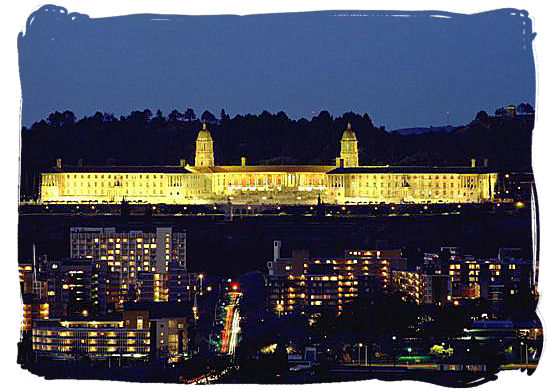
• Under the political system of south Africa, the president is the executive head of the state elected by the parliament for two five year terms.
• President is both the executive head of state and also leads the cabinet.
• The president is subjected to impeachment by the national Assembly under the following conditions: On grounds of violations of the constitution or law, Misconduct, Inability to perform office functions
• The cabinet comprises of the President, Deputy President and the ministers.
• The president appoints the deputy president from amongst the National Assembly members.
The Legislative
• The bicameral Parliament of South Africa consists of the National Assembly and the National Council of Province.
• The National Assembly is presided over by a speaker with the assistance of the Deputy Speaker and members elected from the system of proportional representation.
• The members are elected for five year terms and consist of not more than 400 members.
• The National Council of Provinces elects its own chairperson and comprises of 54 permanent member and 36 special delegates.
• The National Council of Provinces is elected by the nine provincial legislatures.
The Judiciary
• The constitution of South Africa provides for an independent judiciary and the Constitutional Court is the country’s highest court of appeal.
• The constitutional court, the supreme Court share the position of the highest court in the country.
• The Constitutional court only decides on constitutional matters, The supreme court of appeal deals with final appeals on all other matters.
The leading political parties of South Africa are:
• The African National Congress (ANC) – the governing party.
• The Inkatha Freedom Party (Inkatha or IFP)
• Democratic Alliance (DA)
• South Africa Communist Party (SACP)
By Miguel
Culture, Language, Population
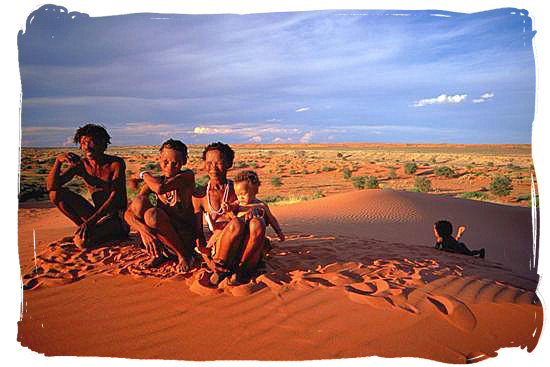
• The population of South Africa is one of the most complex and diverse in the world.
• Of the 45 million South Africans, nearly 31 million are Black, 5 million White, 3 million Coloured and one million Indian. The population density is 32.9 people per km².
• The Black population is divided into four major ethnic groups, namely Nguni, Sotho, Shangaan-Tsonga and Venda.
• There are numerous subgroups of which the Zulu and Xhosa (two subgroups of the Nguni) are the largest.
• The majority of the White population is of Afrikaans descent (60%), with many of the remaining 40% being of British descent.
• Most of the Coloured population live in the Northern and Western Cape provinces, whilst most of the Indian population lives in KwaZulu Natal.
• The Afrikaner population is concentrated in the Gauteng and Free State provinces and the English population in the Western and Eastern Cape and KwaZulu Natal.
• There are eleven official languages in South Africa, namely English, Afrikaans, Ndebele, Sepedi, Xhosa, Venda, Tswana, Southern Sotho, Zulu, Swazi and Tsonga.
South Africa society and culture
• South Africa is known as the rainbow nation.
• South Africa is one of the most multicultural countries in the world.
• In addition to the indigenous black peoples of South Africa colonialism and immigration have brought in white Europeans, Indians, Indo-Malays, Chinese and many more.
• As such it is difficult to generalise at all on South African etiquettes and culture due to the diversity.
Families in south Africa
• The basic unit of South African society is the family, which includes the nuclear family and the extended family or tribe.
•the tribe is the most important community as it is the equivalent of a nation. The tribe provides both emotional and financial security in much the same way the nuclear family does to white or coloured South Africans.
• They consider there extended family as important as their nuclear family.
• The nuclear family is the ultimate basis of the tribe. The tribal and family units are being disrupted by changes in the economic reorganization of the country
• As more people move into the urban areas, they attempt to maintain familial ties, including providing financial support to family members who have remained in the village.
Poverty
• The analysis indicates that 47.1% of South Africa’s population consumed less than the "lower-bound" poverty line proposed by Statistics South Africa in 2007
• 47.1% of the population did not have R322 (in 2000 prices) for essential food and non-food items.
• The poverty rates of South Africa's nine provinces differ significantly, as do those of the urban and rural areas of the country. In 2005/06 the poverty rates ranged from 24.9% in Gauteng and 28.8% in the Western Cape to 57.6% in the Eastern Cape and 64.6% in Limpopo.
• The three provinces with the highest poverty rates (KwaZulu-Natal, the Eastern Cape and Limpopo)
• It should come as no surprise then that fully 60.1% of poor individuals lived in these three provinces.
• There was also a major difference in the poverty rate according to gender: 45% of all female-headed households lived below the "lower-bound" poverty line, compared to only 25% of male-headed households.
• Rural areas are often remote making it expensive and time-consuming for poor people to reach various important facilities.
• About half of the poorest lived more than 30 minutes from the nearest clinic and post office.
• Poverty affected 66.3% of those who had no schooling and 59.9% of those who had not completed primary schooling.
• Two-thirds of South Africa’s poorest have electricity, less than half of all poor households have piped water.
Medicine and health care
• There is a first class but limited modern health care sector for those with medical coverage or the money to pay for the treatment
• Government-subsidized public hospitals and clinics are overstressed, understaffed, and are struggling to deal with the needs of a majority of the population that was under served during white minority rule.
• South Africa has a high HIV infection rate, and if successful strategies for AIDS prevention and care are not implemented, twenty-five percent of the country's young women will die before age thirty.
By Miguel
Weather/Climate
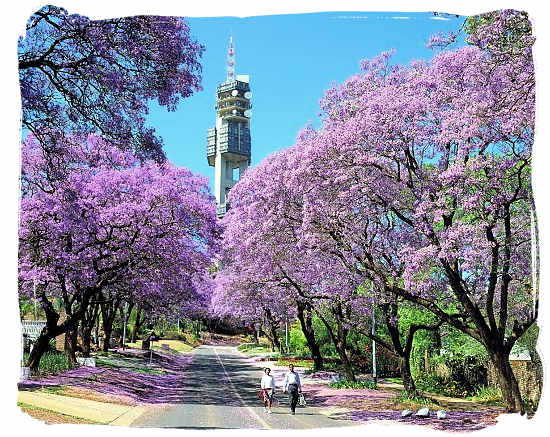
-relatively dry
-average annual rainfall of about 464 mm (the world is about 860mm)
-temperatures tend to be lower than some countries because of its greater elevation above sea level
• Summer
-mid October to mid February is described as HOT
-sunny skies with afternoon thunderstorms that clear quickly
-has a warm, earthly smell in the air
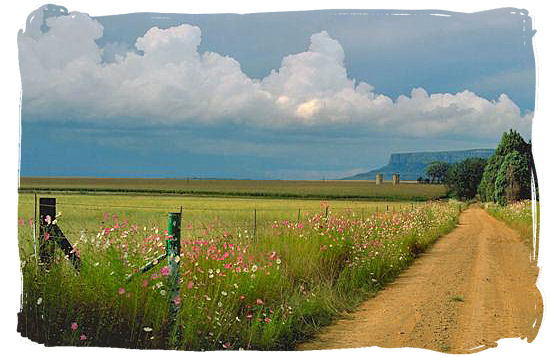
• Autumn
-mid February to April
-presents the best weather
-very little rainfalls
-warm, but not too hot
-does get colder once the season progresses
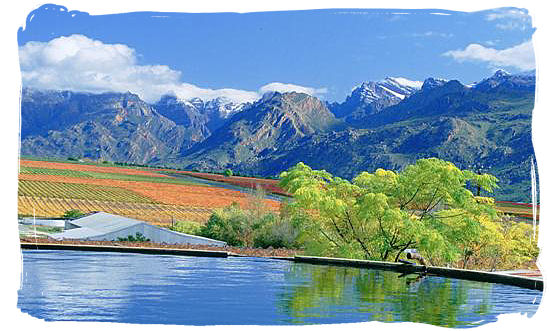
• Winter
-May to July
-dry, sunny, cold nights, crisp days
-western Cape gets most of its rain around this time
-some of the highest mountains in the cape and Drakensberg in KwaZulu-Natal get snow in the winter.
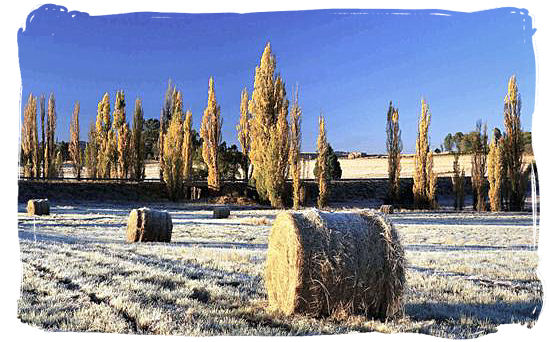
• Spring
-August to mid October
-many plants start to bloom
-Day temperatures rise to an average of between 25 and 30 degrees Celsius
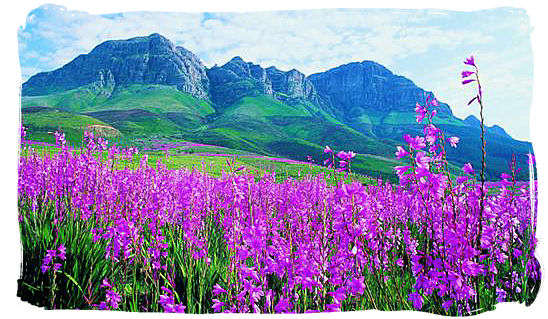
By Cherry
Major Landforms
• Sahara desert
-covers 1/3 of the whole continent
-largest desert in the world
-almost as large as the United States
-approximately 3,500,000 sq. miles
-Rock-strew plains, rolling sand dunes, many sand seas
-regional deserts are the Libyan, Nubian and Western desert of Egypt
-all deserts lie west of the Nile
• Kalahari desert
-covers the southwestern region of South Africa and all of western Namibia
-approximately 100,000 sq. miles
-covered with reddish sand
-lies between the Orange and Zambezi rivers
-consists of dry lake beds
-Yearly rainfall averages about 5 in. in the southwest where there are active sand dunes and 20 in. of rainfall in the northeast
-can rain heavily one day, then be dry as ever the next
-grazing and agriculture is possible in certain areas
-popular tourist spot for the Kgalagadi Transfrontier park
-considered one of Africa’s last “wildlife paradises”
-includes meerkats, hyenas, lions, many species of antelope, birds, reptiles
-first inhabitants of Kalahari are called the the “San” or “bushmen”
-today, only a small amount of bushmen follow traditional ways of living
-modern civilizations threaten natural resources
-coal, copper and nickel deposits were discovered by mineral companies
• Congo River
-also known as “the Zaire”
-dominates the landscape of the Democratic Republic of the Congo and Congo
-flows into Angola, Cameroon and the Central African Republic and Zambia
-approximately 1,400,000 sq. miles
-second longest river in Africa
-fifth longest river in the world
-discharge of 1,500,000 cubic feet of water per second
-consists of freshwater fish that is an important source of protein for the people of central Africa
-best known as a mystical land of mythical beasts, plagues and cannibals
-called “the heart of darkness” by Joseph Conrad
• Atlas Mountains
-located in Tunisia and Morocco
-approximately 1,500 miles
-provides a route between the coast and the Sahara Desert
-lies in northwestern Africa
-highest range found in the southern part of Morocco is called the High Atlas
-highest peak is found in central Morocco which is 11,000 feet
-slopes of the High and Middle atlas have dense forests that include cedar, cork, pine, oak trees
-fertile valleys
-tracts of land where livestock feed
-wide range of mineral deposits that have been rarely touched
-lead, zinc, manganese, iron, antimony, phosphates, gold, silver
-traditionally considered as Berber territory
• Great Rift Valley
-approximately 4,000 miles in length
-expand from the Red Sea area to the South African country of Mozambique
-centuries ago, volcanic eruptions caused chain of geological faults which later created what we call now the Ethiopian Highlands
-also created chains of mountain ridges, perpendicular cliffs, deep lakes, rugged valleys
-Africa’s highest mountains – Mt. Kilimanjaro, Mt. Kenya and Mt. Margherita all front rift valley
-rich source of human fossils that allow the study of human evolution
-bones of hominid (apes) ancestors from modern humans are found
• Nile River
-longest river in the world
-runs about 4,160 miles in length
-drains in the Mediterranean sea
-series of streams, dams, swamps, waterfalls and rapids
-made of major rivers – Albert, Blue, Victoria and White Nile
-average discharge is about 300 million cubic meters per day
-farming, tourism and fishing happens on the Nile River
-you will see traditional Egyptian sailing boats/luxury cruisers traveling up and down
-hundreds of farms along the river, farmers use boats to transfer wheat, cattle, hay, etc.
-fishing is a main source of income and wealth, tons of fish are caught each year
• Sahel
-wide range of land that runs across north-central Africa on the southern edges of the Sahara Desert
-it is the transition zone between tropical places of the south and dry places of the north
-receives very little rain, 6-8 inches a year
-most of the land is a growth of grasses and shrubs
-approximately 2,400 miles
-mainly flat, most of the region lies between 200-400 meters elevation
-home to large populations of endangered mammals
-several kinds of gazelles, cheetahs, lions, African wild dogs, etc.
By Cherry
Sunday, December 6, 2009
Apartheid In South Africa

Photo found at http://www.africancrisis.org/images/Apartheid_South_Africa_Map_of_Black_Homelands.jpg
This is a map of the Cities and Townships that were created to separate whites from coloreds, and blacks during apartheid South Africa in 1948. In between these townships and set boundaries were large golf courses, freeways, and rail road tracks to help further the separation, and to discourage any contact between races.
Apartheid was a way for the Afrikaners and the British to create a "white" South Africa. In order to do that they separated each group of people into segregated sections of colored black and white. Simmilar to the segregation in America, bathrooms, buses, and entrances were also separated by white and non-white.
Police officers were trained to capture and attack, and were open to money bribes. however most of the times during a police raid, blacks didnt have enough for a bribe. everything that the police did was backed by the government because they were under martial law. Peaceful political leaders were thrown in jail like Nelson Mendella, who remained in prison for 30+ years. when he was finally released he became the first Black president.
After Apartheid was over, many whites were prepared for a race war, however instead blacks came up with a plan where you confess your sins to a family that you harmed, and the family can decide whether or not you go to court and be ruled by them, or to be forgiven.
Submitted By Kelsee Franz
A Brief Hisotry

Photo found at http://s36556.gridserver.com/images/JTCModelWorld.jpg
South Africa dates back almost 3 million years ago to Australopithecus Africanus which was one of the earliest human ancestors. Evidence of two groups was found, the San and the Khoikhoi. The San were hunters and gatherers and the Khoikhoi herded cattle and were nomadic.
In 1948 Apartheid government came into power but it wasn’t until 1951 that the HNP or Herenigde Nasional Party gained the majority of constituencies and took over power. Apartheid which means “separation” was all about racial segregation, political and economic discrimination. This separated the black, Coloured, Indian and white South Africans. This separation end initialized in February of 1990 when Nelson Mandela was released. Then on April 27th 1994 the first democratic elections were held in South Africa with all races allowed to vote.
Added by Lynda Sullivan
Subscribe to:
Posts (Atom)